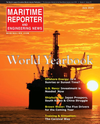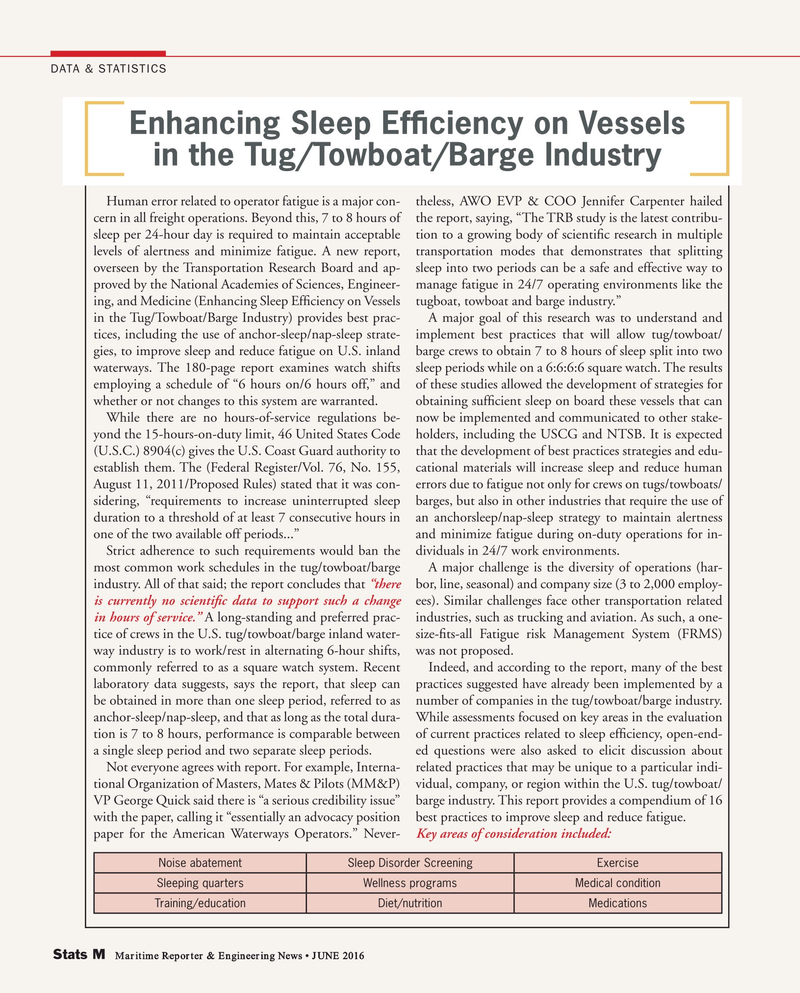
Page 79: of Maritime Reporter Magazine (June 2016)
Annual World Yearbook
Read this page in Pdf, Flash or Html5 edition of June 2016 Maritime Reporter Magazine
DATA & STATISTICS
Enhancing Sleep Ef? ciency on Vessels in the Tug/Towboat/Barge Industry
Human error related to operator fatigue is a major con- theless, AWO EVP & COO Jennifer Carpenter hailed cern in all freight operations. Beyond this, 7 to 8 hours of the report, saying, “The TRB study is the latest contribu- sleep per 24-hour day is required to maintain acceptable tion to a growing body of scienti? c research in multiple levels of alertness and minimize fatigue. A new report, transportation modes that demonstrates that splitting overseen by the Transportation Research Board and ap- sleep into two periods can be a safe and effective way to proved by the National Academies of Sciences, Engineer- manage fatigue in 24/7 operating environments like the ing, and Medicine (Enhancing Sleep Ef? ciency on Vessels tugboat, towboat and barge industry.” in the Tug/Towboat/Barge Industry) provides best prac- A major goal of this research was to understand and tices, including the use of anchor-sleep/nap-sleep strate- implement best practices that will allow tug/towboat/ gies, to improve sleep and reduce fatigue on U.S. inland barge crews to obtain 7 to 8 hours of sleep split into two waterways. The 180-page report examines watch shifts sleep periods while on a 6:6:6:6 square watch. The results employing a schedule of “6 hours on/6 hours off,” and of these studies allowed the development of strategies for whether or not changes to this system are warranted. obtaining suf? cient sleep on board these vessels that can
While there are no hours-of-service regulations be- now be implemented and communicated to other stake- yond the 15-hours-on-duty limit, 46 United States Code holders, including the USCG and NTSB. It is expected (U.S.C.) 8904(c) gives the U.S. Coast Guard authority to that the development of best practices strategies and edu- establish them. The (Federal Register/Vol. 76, No. 155, cational materials will increase sleep and reduce human
August 11, 2011/Proposed Rules) stated that it was con- errors due to fatigue not only for crews on tugs/towboats/ sidering, “requirements to increase uninterrupted sleep barges, but also in other industries that require the use of duration to a threshold of at least 7 consecutive hours in an anchorsleep/nap-sleep strategy to maintain alertness one of the two available off periods...” and minimize fatigue during on-duty operations for in-
Strict adherence to such requirements would ban the dividuals in 24/7 work environments.
most common work schedules in the tug/towboat/barge A major challenge is the diversity of operations (har- industry. All of that said; the report concludes that “there bor, line, seasonal) and company size (3 to 2,000 employ- is currently no scienti? c data to support such a change ees). Similar challenges face other transportation related in hours of service.” A long-standing and preferred prac- industries, such as trucking and aviation. As such, a one- tice of crews in the U.S. tug/towboat/barge inland water- size-? ts-all Fatigue risk Management System (FRMS) way industry is to work/rest in alternating 6-hour shifts, was not proposed.
commonly referred to as a square watch system. Recent Indeed, and according to the report, many of the best laboratory data suggests, says the report, that sleep can practices suggested have already been implemented by a be obtained in more than one sleep period, referred to as number of companies in the tug/towboat/barge industry. anchor-sleep/nap-sleep, and that as long as the total dura- While assessments focused on key areas in the evaluation tion is 7 to 8 hours, performance is comparable between of current practices related to sleep ef? ciency, open-end- a single sleep period and two separate sleep periods. ed questions were also asked to elicit discussion about
Not everyone agrees with report. For example, Interna- related practices that may be unique to a particular indi- tional Organization of Masters, Mates & Pilots (MM&P) vidual, company, or region within the U.S. tug/towboat/
VP George Quick said there is “a serious credibility issue” barge industry. This report provides a compendium of 16 with the paper, calling it “essentially an advocacy position best practices to improve sleep and reduce fatigue. paper for the American Waterways Operators.” Never- Key areas of consideration included:
Noise abatement Sleep Disorder Screening Exercise
Sleeping quarters Wellness programs Medical condition
Training/education Diet/nutrition Medications
Stats M Maritime Reporter & Engineering News • JUNE 2016
STATS II.indd 38 STATS II.indd 38 6/20/2016 5:04:45 PM6/20/2016 5:04:45 PM
MN May16 Layout 1-17.indd 8 4/20/2016 3:35:12 PM

 78
78

 80
80
